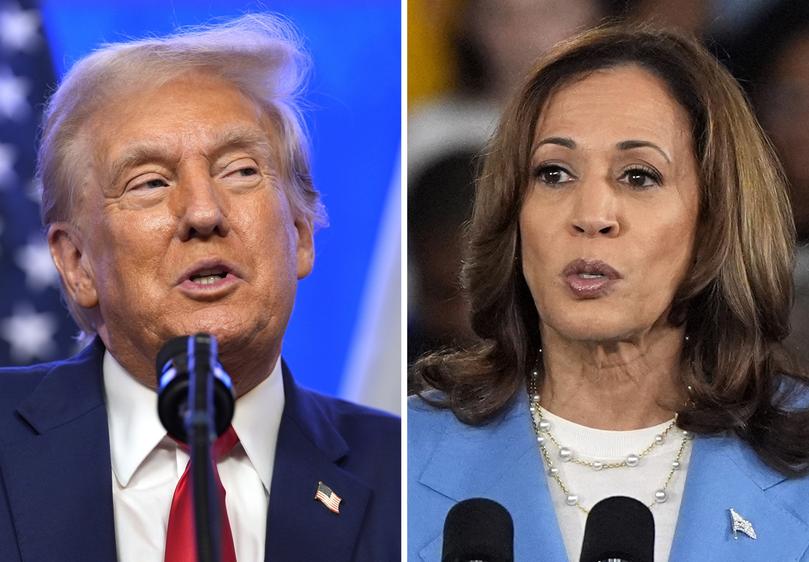THE NEW YORK TIMES: If the choice in 2024 were so obvious, the US election wouldn’t be so close

There are many styles of Harris-Walz signage in my lovely university-town neighbourhood, but the one that’s stickiest in my mind comes with a one-word slogan: “Harris-Walz 2024: Obviously.”
It’s sticky because it gets at something fundamental and fundamentally strange about Trump-era America. The divisions in our country are resilient, the reversion to a 50-50 split seemingly inevitable even amid plague and war and protest. Yet in those regions of America that officially have a professional commitment to debate — the realms of academic and journalistic argument — things are still mostly as they were when Donald Trump first emerged: To oppose him is completely obvious, obligatory, a matter of simple common sense.
Except that it can’t be that obvious or we wouldn’t be where we are.
Sign up to The Nightly's newsletters.
Get the first look at the digital newspaper, curated daily stories and breaking headlines delivered to your inbox.
By continuing you agree to our Terms and Privacy Policy.So let’s take one last survey of why some waverers might not yet be sold on Kamala Harris and Tim Walz, by returning to where this all began: the world of 2016, when Americans normally disinclined to vote for liberals were first informed that there was no other reasonable choice.
In that world, the Hillary Clinton campaign offered the country an implicit bargain. The promise was not some sort of dramatic bipartisan moderation to meet the Trumpist threat; on policy Clinton’s campaign was somewhat more left-wing than Barack Obama’s White House.
Rather the promise was that even if you disagreed with liberalism’s elites on policy, you could trust them in three crucial ways: They would avoid insanity, they would maintain stability, and they would display far greater intelligence and competence than Trump and his hangers-on.
The promise of sanity was broken first. Under Trumpian and especially Covidian conditions, the culture of elite liberalism lurched toward fanaticism, embracing radical and fanciful ideas to a degree that I had not imagined possible.
At the time some liberals resisted this lurch, but many others fell silent under pressures that felt almost McCarthyite in their threats to livelihoods and reputations.
Today more liberals concede that things got a bit kooky for a while. But the tendency is still to cast the high tide of wokeness as just a silly season whose effects were hardly comparable to right-wing depredations.
To me, though, the further that we get from that moment, the more remarkable the damage looks. For instance: After the liberal establishment was radicalized by the killing of George Floyd into a temporary repudiation of normal policing on “anti-racist” grounds, America experienced a dramatic wave of homicides, on a scale unique among developed countries in the COVID era, in which thousands and thousands of people died unnecessarily.
Or again, America in that season mainstreamed experimental and unproven chemical and surgical treatments on thousands of gender-dysphoric young people, with the enthusiastic support of the medical establishment and then the Biden administration, because people with a normal degree of scepticism were afraid of being called transphobes.
Even before you get into harder-to-quantify issues of intellectual corruption, damage to schools and social life and mental health, there is a basic physical toll here — on “bodies,” to use the language that some progressives favor — that undermines the liberal claim to represent sanity against populist derangement.
And it undermines those claims even if the craziness has passed for now, because we could see how a figure like Kamala Harris behaved during that period. Is she a true believer in every notion she endorsed in the 2020 campaign? Perhaps not. But neither is there any good reason to think that she would offer principled resistance if liberalism entered a fevered state again.

Then alongside sanity at home, there is the failure of liberalism to deliver stability abroad. When Trump was first elected president I expected a period of testing — cross-border incursions, terrorist violence, a coordination between our adversaries against a wobbling Pax Americana.
All of that happened — but under Joe Biden’s leadership, not Trump’s. The position of the United States is more parlous today than when Trump left office, the risk of a genuine world war has intensified, and the cost of destabilization is already measured in thousands upon thousands of dead.
I don’t think all this reflects terrible case-by-case decision-making by the Biden administration. But in the aggregate, you can see a severe weakness in liberal internationalism right now — a tendency to extend itself rhetorically without the material investments required to back those promissory notes, a limpness in its relationship to allies who take our patience and protection for granted, a difficulty figuring out how to negotiate with enemies after you’ve spent so much time denouncing them. (We are clearly paying the price for missing a 2023-era window for an armistice in Ukraine.)
One might prefer well-meaning weakness to the Trumpian alternative of an amoral president seeking retrenchment, surrounded by foreign policy hands trying to use his mercurial persona to keep our rivals off balance. But it’s possible the Trumpian formula yielded better results for a reason, and it’s not at all clear that Harris is ready for the tests that Biden’s failing foreign policy will hand on to her.
Especially since the final promise of 2016-era liberalism — its claim to have a profound advantage in competence and intelligence — is not exactly vindicated by the Harris-Walz ticket.
I understand that we are close enough to the election that this last point will be furiously rejected. But notwithstanding the great rally around her after Biden’s bow-out, the Democratic nominee for president is still the Dan Quayle-like figure that almost everybody saw just a little while ago, still vague on policy and painful in extended interviews, still carrying a record as a vice president that inspires little confidence in her abilities.
By comparison, Clinton was clearly a more serious policymaker, Biden was clearly better at the work of politics, and both were more experienced in ways that matter to a chief executive. Harris’ selection of running mate was a telling double-down on mediocrity: She picked a partner who would cast no shade on her own capabilities, even when there were clear political incentives to choose otherwise.
Better mediocrity than Trump — except that in 2024, unlike 2016, the Republican ticket has the ballast of a running mate who is capable of going multiple rounds in any format (I may have a personal bias in JD Vance’s favor, but I think his performance in interviews and the VP debate have been extremely effective), and the fervent involvement of the man responsible for America’s most successful automotive startup and rockets that are the wonder of the world.
There are people who will vote for the Republican ticket this time, in other words, because they see a potential inner circle with more capacities for thinking and doing than what the Democrats are offering.
Thinking and doing in the service of Trump’s authoritarian impulses … Yes, whatever we have learned about liberalism since 2016, we have also learned just how far Trump will push the constitutional order in pursuit of his ambitions, and that remains a strong reason to rule out voting for him.
But in making that choice you need to make some concession to uncertainty — to see the confounding surprises the last eight years have delivered to some NeverTrump assumptions, the reasonable fears that attend an extension of the Biden-Harris era, the damage our society has suffered from forces that aren’t Trumpian in any way.
I don’t like columnist endorsements, and my own choice will be made in the same way as my choices were made in 2016 and 2020 — at the last minute, in the privacy of the voting booth, probably with subsequent regrets.
My only advice is to vote with a conscience informed by all the twists and turns we’ve recently experienced — the better to be prepared for surprises yet to come.
This article originally appeared in The New York Times.
© 2024 The New York Times Company
Originally published on The New York Times
